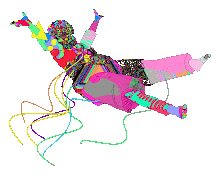
Arthur Charles Clarke, mais conhecido como Arthur C. Clarke (Minehead, Somerset, 16 de dezembro de 1917) é um escritor e inventor britânico, autor de obras de divulgação científica e de ficção científica, como por exemplo os contos The Sentinel, A Estrela, A muralha das Trevas, As Canções da Terra Distante e os romances 2001: Uma Odisséia no Espaço, 2010: Uma Odisséia no Espaço 2, 2061: Uma Odisséia no Espaço 3, 3001: A Odisséia Final, Encontro com Rama, O Enigma de Rama, O Jardim de Rama, A Revelação de Rama, As Fontes do Paraíso, O Berço dos Super-Humanos, A Cidade e as Estrelas.
Desde pequeno mostrou sua fascinação pela astronomia, a ponto de, utilizando um telescópio caseiro, desenhar um mapa da Lua. Durante a Segunda Guerra Mundial, serviu na Royal Air Force (Força Aérea Real britânica) como especialista em radares, envolvendo-se no desenvolvimento de um sistema de defesa por radar, sendo uma peça importante do êxito na batalha da Inglaterra. Depois, estudou Física e Matemática no King's College de Londres.
Talvez sua contribuição de maior importância seja o conceito de satélite geoestacionário como futura ferramenta para desenvolver as telecomunicações. Ele propôs essa idéia em um artigo científico intitulado "Can Rocket Stations Give Worldwide Radio Coverage?", publicado na revista Wireless World em Outubro de 1945. A órbita geoestacionária também é conhecida, desde então, como órbita Clarke.
Desde 1956 vive em Colombo, no Sri Lanka , em parte devido a seu interesse pela fotografia e exploração submarina.
Teve dois de seus romances levados ao cinema, 2001: Uma Odisseia no Espaço dirigido por Stanley Kubrick (1968) e 2010: O ano do contacto dirigido por Peter Hyams (1984), sendo o primeiro considerado um ícone tão importante da ficção científica mundial que especialistas lhe atribuem forte influência sobre a maioria dos filmes do gênero que lhe sucederam.
Também em reconhecimento a Clarke, o asteróide 4923 foi batizado com seu nome, assim como uma espécie de dinossauro Ceratopsian, o Serendipaceratops Arthurcclarkei, descoberto em Inverloch, Austrália.
















